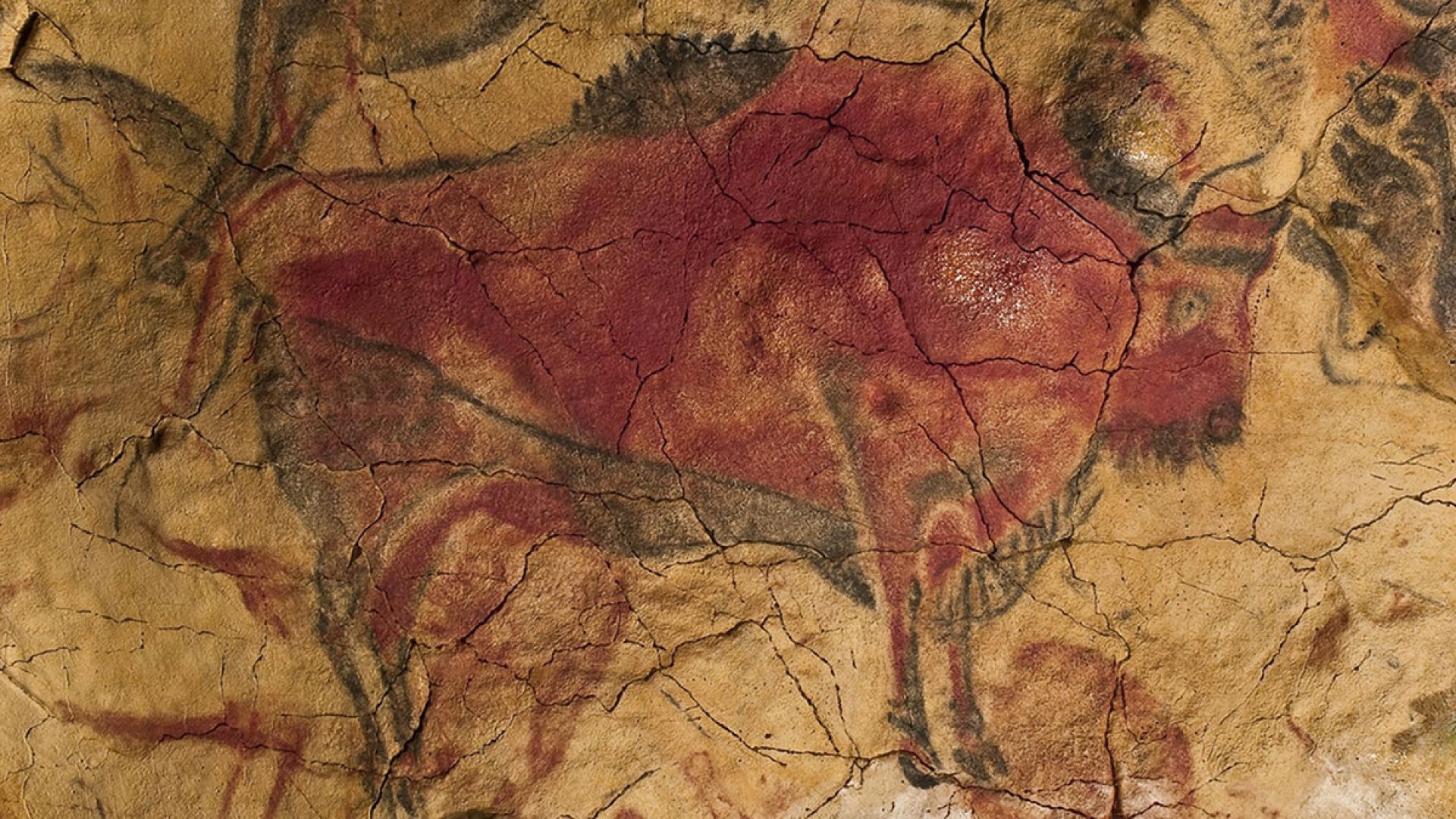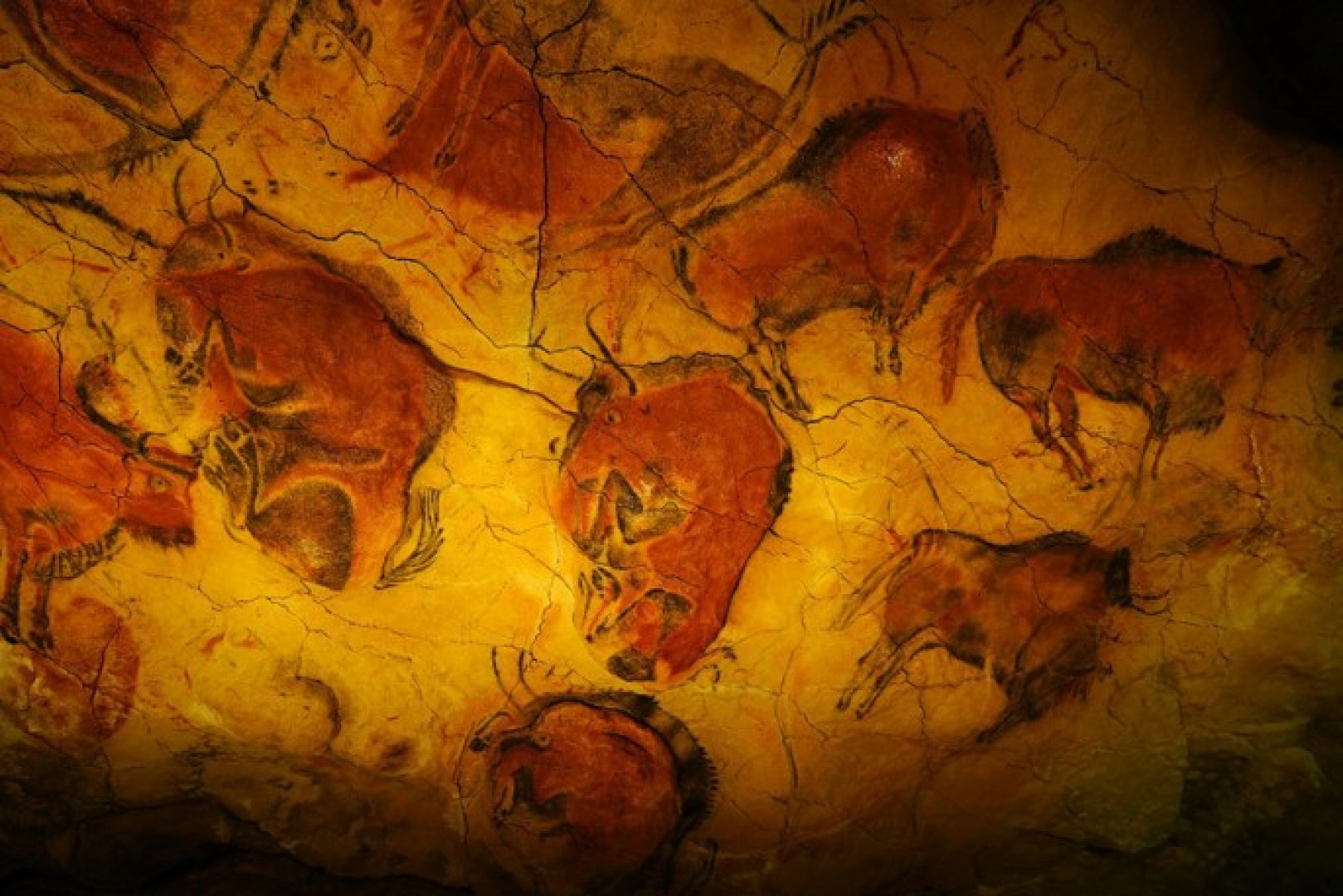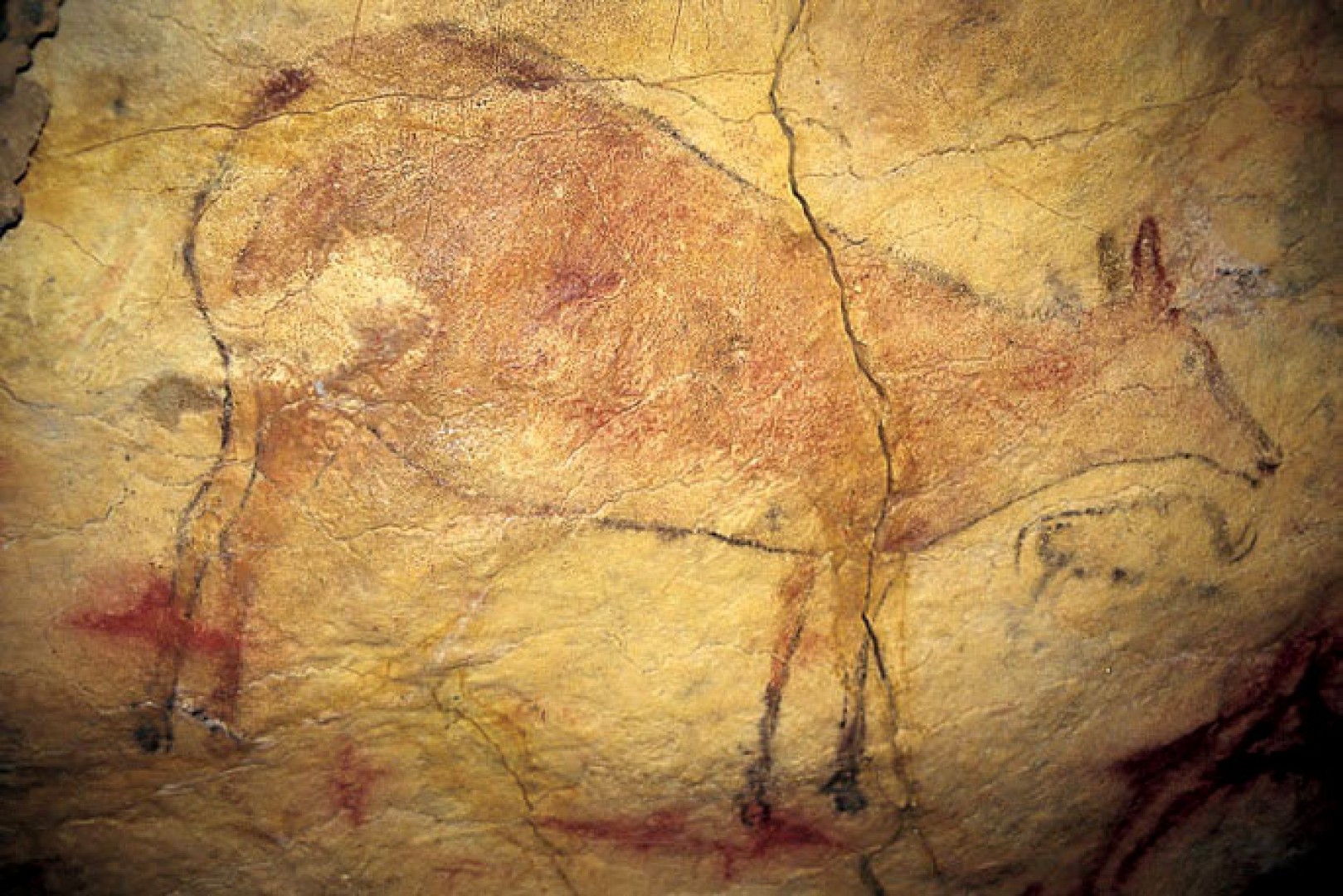Introduction
Nestled in the green hills of Cantabria, Spain, lies a treasure trove of history that has captivated the world for over a century. The Altamira Cave, often referred to as the “Sistine Chapel of Paleolithic Art”, stands as a testament to the artistic prowess of our ancient ancestors. Its significance in world history cannot be overstated, offering a rare window into the lives, beliefs, and skills of prehistoric humans.
The cave’s intricate paintings, predominantly of bison, hands, and abstract symbols, are not just mere drawings on a wall. They are a glimpse into prehistoric art, a visual diary of a time long gone. These paintings, believed to be around 20,000 years old, showcase a sophistication and understanding of artistic techniques that challenge many modern perceptions of prehistoric man. The use of the cave’s natural contours to give depth and life to the paintings, the selection of pigments, and the sheer scale of some of the artwork is nothing short of awe-inspiring.
Visiting the Altamira Cave is not just about witnessing ancient art; it’s about experiencing a place where history, art, and anthropology converge. It’s about standing in the very spot where ancient humans once stood, expressing their stories, beliefs, and perhaps even their dreams on the cave walls.
For those keen on delving deeper into the history and significance of Altamira, the nearby Altamira Museum offers a wealth of information and even boasts a meticulously crafted replica of the cave for visitors to explore, ensuring the preservation of the original site (www.museodealtamira.mcu.es).
In the subsequent sections, we will journey through the discovery of this magnificent cave, delve into the mysteries behind the art, and offer insights for those wishing to experience Altamira’s magic firsthand.

The discovery of Altamira
In the rolling hills of northern Spain, in 1879, a discovery was made that would forever change our understanding of prehistoric art and culture. The Altamira Cave, with its stunning ceiling adorned with vivid paintings of bison, deer, and other animals, was stumbled upon by a local man named Marcelino Sanz de Sautuola and his young daughter, María.
María was the first to notice the extraordinary paintings. As the story goes, while her father was examining some artifacts on the cave floor, she looked up and exclaimed, “Look, Papa, oxen!” pointing to the detailed bison figures painted above. This initial revelation was met with a mix of awe and disbelief. The sheer sophistication and quality of the art were unlike anything seen from the Paleolithic era.
However, the discovery’s impact was not immediately celebrated. When Sautuola and the Spanish archaeologist Juan Vilanova y Piera published their findings, the academic community was skeptical. The prevailing belief of the time was that prehistoric humans lacked the capability or sophistication to produce such intricate artwork. Many accused Sautuola of forgery, claiming the paintings were a modern creation meant to deceive.
The controversies surrounding Altamira’s authenticity persisted for years. It wasn’t until similar cave art discoveries were made in France and other parts of Spain that the tide began to turn. By the early 20th century, as more evidence mounted and with the backing of eminent archaeologists like Émile Cartailhac, the Altamira Cave’s significance was finally recognized. Cartailhac, once a skeptic, even penned a public apology to Sautuola, titled “Mea Culpa d’un Sceptique,” acknowledging the cave’s genuine Paleolithic origins.
Today, the Altamira Cave stands as a UNESCO World Heritage site, a testament to its global importance and the rich tapestry of human history it represents. For those interested in further exploring the cave’s tumultuous journey to recognition, the Altamira Museum offers detailed exhibits and insights (www.museodealtamira.mcu.es).
Description of the paintings
The Altamira Cave is not just a relic of the past; it’s a vibrant canvas that captures the essence of a bygone era. The paintings within this cave are a testament to the artistic prowess and deep spiritual connection of our Paleolithic ancestors.

Techniques and materials used
The artists of Altamira were not just painters; they were innovators. They utilized a mixture of natural pigments, primarily ochre, charcoal, and manganese, to bring their visions to life. These pigments were often mixed with animal fat to create a rudimentary form of paint. The artists would then apply these paints using their fingers, brushes made from animal hair, or even via a primitive form of airbrushing, where they’d blow the pigment through hollow bones.
The cave’s uneven surfaces and contours were not seen as obstacles but as opportunities. The artists ingeniously incorporated the cave’s natural bumps and depressions into their artwork, giving a three-dimensional effect to the animals they depicted. This technique made the figures seem alive, as if they were moving across the cave’s ceiling.
Iconic depictions: bison, hands, and abstract symbols
The most iconic of all the paintings in Altamira is undoubtedly the bison. These majestic creatures are depicted with a level of detail and realism that is breathtaking. Their humped backs, powerful legs, and curved horns are rendered with such precision that they seem to burst from the cave walls. The bison are not static; they appear to be in motion, capturing moments of rest, tension, and play.
Equally intriguing are the handprints that dot the cave. These negative silhouettes, created by placing a hand on the wall and then blowing pigment around it, offer a direct link to the individuals who once inhabited or visited the cave. They serve as a poignant reminder that behind every painting, there’s a human story waiting to be told.
In addition to the animals and handprints, the cave also features a series of abstract symbols. These geometric shapes, lines, and dots might seem random, but they likely held significant meaning for their creators. While their exact significance remains a topic of debate among archaeologists, they offer a glimpse into the symbolic or spiritual world of Paleolithic people.
The Altamira Cave is more than just a gallery of ancient art; it’s a window into the soul of humanity’s distant ancestors. For those wishing to delve deeper into the mysteries of Altamira, the Altamira Museum provides a wealth of information and even a replica of the cave for visitors to explore (www.museodealtamira.mcu.es).
The importance in prehistoric art
The caves of Altamira, nestled in the northern regions of Spain, are not just a testament to the artistic capabilities of our ancestors, but also a window into the soul of prehistoric humanity. The intricate paintings found within these caves offer a unique insight into the lives, beliefs, and values of those who lived tens of thousands of years ago.
Altamira’s place in paleolithic art
The Altamira Cave, discovered in the late 19th century, quickly became a focal point in the study of Paleolithic art. Its ceiling, adorned with vivid depictions of bison, deer, and other animals, showcases a level of sophistication and detail that was previously unimaginable for the era. The use of natural contours of the cave to give a three-dimensional effect to the paintings reveals a deep understanding of artistry and an innate ability to use the environment to enhance artistic expression.
The significance of Altamira in the realm of prehistoric art cannot be understated. It serves as a benchmark, a gold standard, against which other discoveries are often compared. The cave’s recognition as a UNESCO World Heritage Site further cements its importance in the annals of human history.
Comparison with other prehistoric art sites
While Altamira stands out for its detailed depictions, it is not alone in its grandeur. Across Europe, various sites like Lascaux in France, Cosquer Cave beneath the seabed near Marseille, and the Creswell Crags in the UK offer glimpses into prehistoric art. However, what sets Altamira apart is the sheer vibrancy and preservation of its paintings. The deep reds, blacks, and ochres used in Altamira are remarkably well-preserved, making the images pop out with a vivacity that’s rare for such ancient sites.
Yet, when we place Altamira alongside these other monumental sites, a broader narrative emerges. It’s a story of interconnectedness, of shared human experiences across different geographies. The similarities in the motifs, techniques, and materials used across these distant locations hint at a shared cultural heritage, a universal language of art that transcended borders.
The Altamira Cave is not just a site of historical importance; it’s a beacon of human creativity, a testament to our shared past, and a reminder of the timeless nature of art.

Visiting Altamira today
The allure of ancient art beckons many to the Altamira Cave, but it’s not just the cave that draws attention. The entire experience, from the museum to the replica, is designed to transport visitors back to a time when early humans expressed their experiences on cave walls.
The Altamira museum and replica cave
The original Altamira Cave, due to its immense historical and archaeological value, has limited access to ensure its preservation. However, the Altamira Museum offers a meticulously crafted replica of the cave, known as the “Neocave”. This reproduction allows visitors to experience the magic of the paintings without harming the original. The museum itself is a treasure trove of information, providing insights into the lives of Paleolithic humans, the significance of the art, and the history of the cave’s discovery.
Tips for visitors and best times to go
The best time to visit Altamira is during the spring and fall, avoiding the summer tourist rush. It’s advisable to book tickets in advance, especially if you’re visiting during peak times. Wear comfortable shoes, as there’s a bit of walking involved. Photography inside the Neocave is prohibited, so be prepared to store those memories in your mind’s eye.
How to get there
Altamira is located near the town of Santillana del Mar in Cantabria. If you’re driving, there’s ample parking at the museum. For those relying on public transport, regular buses run from Santander to Santillana del Mar. From there, it’s a short taxi ride or a pleasant walk to the museum.
For more detailed information and to plan your visit, the official website of the Altamira Museum (museodealtamira.mcu.es) provides a wealth of resources.
The UNESCO World Heritage status
The Altamira Cave, with its mesmerizing rock paintings, isn’t just a Spanish treasure; it’s a gift to humanity. This sentiment was solidified when the cave was granted UNESCO World Heritage status, placing it among other iconic landmarks that have shaped human history.
Recognition and its implications
In 1985, the Altamira Cave was inscribed on the UNESCO World Heritage List, a testament to its outstanding universal value. This recognition isn’t merely honorary. Being on this list means that the site holds significance not just for the local or national community, but for all of humanity. The status brings with it a commitment to preservation, ensuring that future generations can also experience the wonder of Altamira. Moreover, it has boosted the cave’s global profile, attracting researchers, historians, and tourists from around the world.
Conservation efforts for the future
With great recognition comes great responsibility. The cave’s delicate environment, particularly the ancient paintings, is susceptible to damage from external factors, including the very visitors who come to admire them. To combat this, a series of measures have been implemented. Access to the original cave is highly restricted, with the replica “Neocave” serving the bulk of visitors. Advanced monitoring systems track environmental conditions, ensuring that any potential threats to the paintings are swiftly addressed. Furthermore, collaborations with international conservation bodies ensure that the latest techniques are employed to preserve this prehistoric masterpiece.
The dedication to conserving Altamira is evident in the efforts of institutions like the Altamira Museum (museodealtamira.mcu.es) and the support from UNESCO. Together, they ensure that the legacy of our ancient ancestors, so beautifully depicted on the walls of Altamira, endures for millennia to come.
The mystery and theories behind the art
The Altamira Cave, with its intricate rock paintings, has long been a subject of fascination and intrigue. These ancient depictions, while visually stunning, also pose a myriad of questions. What do they represent? Why were they painted? And what can they reveal about the lives and beliefs of our prehistoric ancestors?
Interpretations of the paintings
Over the years, various theories have been proposed regarding the meaning behind the Altamira paintings. Some scholars believe that the images, particularly those of bison and other animals, had a ritualistic or spiritual significance. They might have been painted as part of hunting rituals, invoking the favor of the spirits for a successful hunt. Others suggest that the paintings could be a form of early storytelling or documentation, capturing significant events or tales from the community.
Another intriguing theory posits that the abstract symbols found alongside the animal depictions could be an early form of written language or symbolic communication. These symbols might represent clan markings, celestial events, or even shamanistic visions.
What they tell us about prehistoric life and beliefs
Beyond their potential symbolic meanings, the paintings offer a window into the daily lives of Paleolithic humans. The meticulous detail in the animal depictions indicates a deep familiarity with local fauna, suggesting that hunting played a significant role in their society. The presence of handprints, both of adults and children, hints at a communal involvement in the creation of the art, perhaps as a rite of passage or a community bonding activity.
Furthermore, the sheer effort and skill involved in creating these paintings, in the dim, hard-to-reach recesses of a cave, indicate that they held significant importance. Whether spiritual, communal, or informational, these paintings were clearly valued by their creators.
The Altamira Cave paintings, while shrouded in mystery, provide invaluable insights into the world of our ancestors. They remind us of the deep-rooted human need to communicate, to understand, and to be remembered.
For those keen on delving deeper into the world of prehistoric art and its interpretations, institutions like the National Archaeological Museum of Spain (man.es) offer extensive collections and research on the subject, shedding light on the enigmatic world of ancient artists.
Conclusion
The Altamira Cave, nestled in the northern regions of Spain, stands as a testament to the artistic prowess and spiritual depth of our prehistoric ancestors. Its intricate paintings, dating back thousands of years, offer a tantalizing glimpse into a world long gone, yet one that feels strangely familiar.
The enduring allure of Altamira
The cave’s artistry is not just a visual spectacle but also a profound connection to our shared human heritage. Every brushstroke, every handprint, speaks of a time when man sought to understand and represent his environment. The cave, with its dimly lit chambers and echoing silence, seems to reverberate with the whispers of ancient artists, sharing tales of hunts, rituals, and the mysteries of existence. This enduring allure has drawn countless visitors, historians, and art enthusiasts to Altamira, making it a pivotal landmark in the world of prehistoric art.
Spain’s rich tapestry of history and heritage
Altamira is but one jewel in Spain’s crown of historical treasures. From the ancient Roman ruins of Tarragona to the Moorish palaces of Granada, Spain boasts a rich tapestry of cultures, stories, and epochs. The cave paintings of Altamira serve as a poignant reminder of this legacy, urging modern-day travelers to delve deeper into Spain’s multifaceted past. It’s a journey of discovery, where every corner turned reveals another layer of history, another tale waiting to be told.
In conclusion, the Altamira Cave is more than just a tourist destination. It’s a bridge to our past, a celebration of human creativity, and a testament to Spain’s enduring role as a custodian of world heritage.
References and further reading
- National Archaeological Museum of Spain – man.es: An extensive collection of prehistoric artifacts and research materials.
- Leroi-Gourhan, A. (1982). The Art of Prehistoric Man in Western Europe. Thames and Hudson.
- Altamira Museum and Research Centre – museodealtamira.mcu.es: Dedicated to the study and promotion of the Altamira Cave and its art.
- Bahn, P. (1998). The Cambridge Illustrated History of Prehistoric Art. Cambridge University Press.
For those keen on exploring further, Spain offers a plethora of museums, historical sites, and guided tours that delve into its rich history, ensuring that the story of Altamira and its ilk continues to inspire and educate generations to come.





